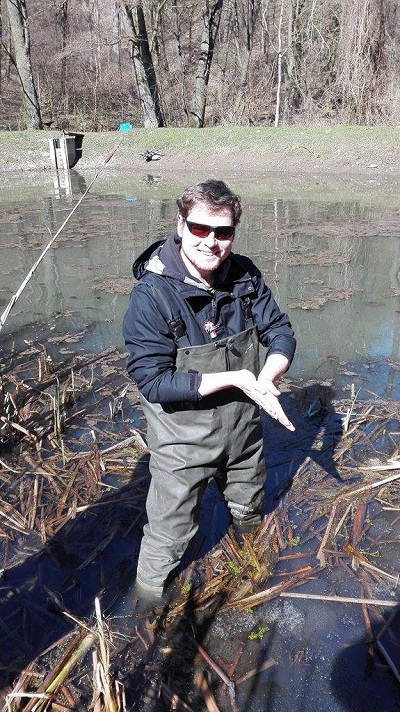
I graduated from Eötvös Loránd University, at the specialization of Ecology, Evolutionary and Conservation Biology in 2014. Since then I am working in the Lendület Evolutionary Ecology Research Group as a PhD student. My research focuses on the phenotypic plasticity and evolutionary ecology of amphibian chemical defenses against pathogens, with particular regard to the amphibian chytrid fungus Batrachochytrium dendrobatidis. The main examined antimicrobial chemical compounds are antimicrobial peptides from Rana dalmatina and the toxins (bufadienolides) of Bufo bufo. I conduct laboratory experiments and also a lot of fieldwork in the Pilis Mountains, Hungary. Formerly I participated in mesocosm and laboratory experiments with herbicides and amphibians. Beside these, I often join herpetofauna surveys in Hungary and abroad (Slovakia, Croatia, Albania, Greece).
Contacts
Address here.
Phone: +36 1 3918607
E-mail: ujszegi.janos@atk.hu
Publications
Reprints from here.
Bókony V., Balogh E., Ujszegi J., Ujhegyi N., Szederkényi M., Hettyey A. 2024. Tadpoles develop elevated heat tolerance in urban heat islands regardless of sex. Evolutionary Biology 51: 209-216.
Ujszegi J., Boros Z., Fodor A., Vajna B., Hettyey A. 2023. Metabolites of Xenorhabdus bacteria are potent candidates for mitigating amphibian chytridiomycosis. AMB Express 13: 88.
Herczeg D., Holly D., Kásler A., Bókony V., Papp T., Takács-Vágó H., Ujszegi J., Hettyey A. 2023. Amphibian larvae benefit from a warm environment under simultaneous threat from chytridiomycosis and ranavirosis. Oikos 11: e09953.
Kásler A., Holly D., Herczeg D., Ujszegi J., Hettyey A. 2023. Chytridiomycosis and climate change: exposure to Batrachochytrium dendrobatidis and mild winter conditions do not increase mortality in juvenile agile frogs during hibernation. Animal Conservation 26: 654-662.
Kásler A., Ujszegi J., Holly D., Jaloveczki B., Gál Z., Hettyey A. 2022. In vitro thermal tolerance of a hypervirulent lineage of Batrachochytrium dendrobatidis: Growth arrestment by elevated temperature and recovery following thermal treatment. Mycologia 114: 661-669.
Kásler A., Ujszegi J., Holly D., Üveges B., Móricz Á.M., Herczeg D., Hettyey A. 2022. Metamorphic common toads keep chytrid infection under control, but at a cost. Journal of Zoology 317: 159-169.
Ujszegi J., Bertalan R., Ujhegyi N., Verebélyi V., Nemesházi E., Mikó Z., Kásler A., Herczeg D., Szederkényi M., Vili N., Gál Z., Hoffmann O.I., Bókony V., Hettyey A. 2022. “Heat waves” experienced during larval life have species-specific consequences on life-history traits and sexual development in anuran amphibians. Science of the Total Environment 835: 155297.
Ujszegi J., Ludányi K., Móricz Á.M., Krüzselyi D., Drahos L., Drexler T., Németh M.Z., Vörös J., Garner T.W.J., Hettyey A. 2021. Exposure to Batrachochytrium dendrobatidis affects chemical defences in two anuran amphibians, Rana dalmatina and Bufo bufo. BMC Ecology and Evolution 21:135.
Mikó Z., Nemesházi E., Ujhegyi N., Verebélyi V., Ujszegi J., Kásler A., Bertalan R., Vili N., Gál Z., Hoffmann O.I., Hettyey A., Bókony V. 2021. Sex reversal and ontogeny under climate change and chemical pollution: are there interactions between the effects of high temperature and 17α-ethinylestradiol on early development in agile frogs? Environmental Pollution 285: 117464.
Herczeg D., Ujszegi J., Kásler A., Holly D., Hettyey A. 2021. Host–multiparasite interactions in amphibians: a review. Parasites & Vectors 14: 296.
Ujszegi J., Molnár K., Hettyey A. 2021. How to disinfect anuran eggs? Sensitivity of anuran embryos to chemicals widely used for the disinfection of larval and post‐metamorphic amphibians. Journal of Applied Toxicology 41: 387-398.
Ujszegi J., Vajna B., Móricz Á.M., Krüzselyi D., Korponai K., Krett G., Hettyey A. 2020. Relationships between chemical defenses of common toad (Bufo bufo) tadpoles and bacterial community structure of their natural aquatic habitat. Journal of Chemical Ecology 46: 534-543.
Mizsei E., Boros Z., Lovas‐Kiss Á., Szepesváry C., Szabolcs M., Rák G., Ujszegi J., Gál Z., Lengyel S., Puskás G. 2019. A trait‐based framework for understanding predator–prey relationships: Trait matching between a specialist snake and its insect prey. Functional Ecology 33: 2354-2368.
Hettyey A., Ujszegi J., Herczeg D., Holly D., Vörös J., Schmidt B.R., Bosch J. 2019. Mitigating disease impacts in amphibian populations: capitalizing on the thermal optimum mismatch between a pathogen and its host. Frontiers in Ecology and Evolution 7:254.
Ujszegi J., Móricz Á.M., Krüzselyi D., Hettyey A. 2017. Skin toxin production of toads changes during early ontogeny but is not adjusted to the microbiota of the aquatic environment. Evolutionary Ecology 31: 925–936.
Mikó Zs., Ujszegi J., Hettyey A. 2017. Age-dependent changes in sensitivity to a pesticide in tadpoles of the common toad (Bufo bufo). Aquatic Toxicology 187: 48-54.
Mikó Zs., Ujszegi J., Gál Z., Hettyey A. 2017. Effects of a glyphosate-based herbicide and predation threat on the behaviour of agile frog tadpoles. Ecotoxicology and Environmental Safety 140: 96–102.
Mikó Z., Ujszegi J., Gál Z., Hettyey A. 2017. Standardize or diversify experimental conditions in ecotoxicology? A case study on herbicide toxicity to larvae of two anuran amphibians. Archives of Environmental Contamination and Toxicology 73: 562–569.
Ujszegi J., Gál Z., Mikó Zs., Hettyey A. 2016. No effect of a glyphosate-based herbicide on larval dragonflies (Aeshna cyanea) and adult newts (Lissotriton vulgaris) in a laboratory-based experiment. Acta Zoologica Academiae Scientiarum Hungaricae 62: 355–367.
Bókony V., Móricz Á.M., Tóth Zs., Gál Z., Kurali A., Mikó Zs., Pásztor K., Szederkényi M., Tóth Z., Ujszegi J., Üveges B., Krüzselyi D., Capon R.J., Hoi H., Hettyey A. 2016. Variation in chemical defense among natural populations of common toad (Bufo bufo) tadpoles: the role of environmental factors. Journal of Chemical Ecology 42: 329-338.
Ujszegi J., Gál, Z., Mikó Zs., Hettyey A. 2015. No observable effect of a glyphosate-based herbicide on two top predators of temporal water bodies. Environmental Toxicology and Chemistry 34: 307-313.
Mikó Zs., Ujszegi J., Gál Z., Imrei Z., Hettyey A. 2015. Choice of experimental venue matters in ecotoxicology studies: Comparison of a laboratory-based and an outdoor mesocosm experiment. Aquatic Toxicology 167: 20-30.
Hettyey A., Vági B., Kovács T., Ujszegi J., Katona P., Szederkényi M., Pearman P.B., Griggio M., Hoi H. 2014. Reproductive interference between Rana dalmatina and R. temporaria affects reproductive success in natural populations. Oecologia 176: 457-464.
